Birdfinding.info ⇒ Fairly common in a wide range of wooded habitats at all elevations. Readily found around the coastal towns Jacmel and Zanglais d’Aquin, and at Pic Macaya Biosphere Reserve.
Gray-crowned Palm-Tanager
Phaenicophilus poliocephalus
Endemic to southern Haiti. Confined to the Tiburon Peninsula, Grande Cayemite Island; Île-à-Vache; and Gonâve.
Occurs in all types of woodland and semiopen habitats, including settled areas.
Its status east of La Visite National Park into the southwestern Dominican Republic is in doubt, lacking conclusive documentation. It has been reported in the Dominican Republic on the northern and southern slopes of the Sierra de Bahoruco, east to Hoyo del Pelempito—but its similarity to the immature Black-crowned casts doubt on these sight records.
Identification
Distinctive throughout most of its range, where it is easily recognized by its bright olive upperparts, gray underparts, white whisker stripe, and black mask with white spots around the eye.
The Gonâve subspecies coryi is reportedly paler than the others, with a white belly and white patch on the crown.
Easily confused with immature Black-crowned Palm-Tanager. (See below.)
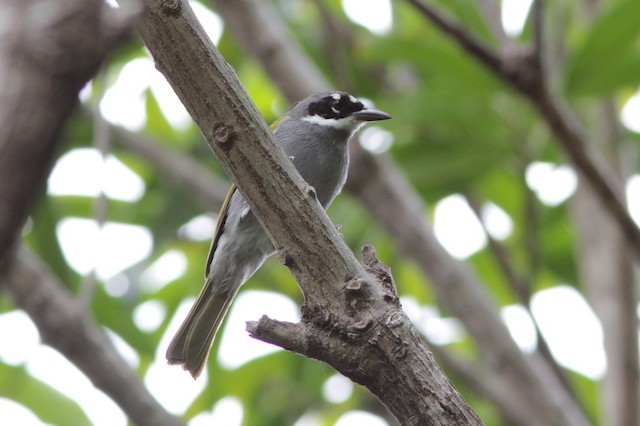
Gray-crowned Palm-Tanager. (Zanglais d’Aquin, Haiti; December 13, 2017.) © Richard Dunn

Gray-crowned Palm-Tanager. (Zanglais d’Aquin, Haiti; May 7, 2016.) © Sean Christensen
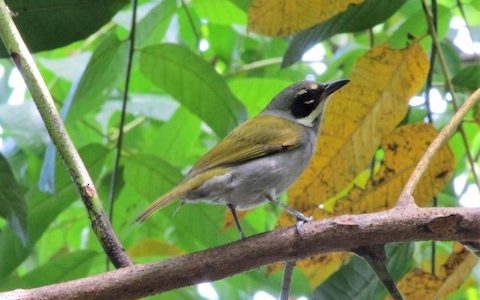
Gray-crowned Palm-Tanager. (Zanglais d’Aquin, Haiti; October 27, 2018.) © Sean Christensen

Gray-crowned Palm-Tanager. (Camp-Perrin, Haiti; April 11, 2014.) © Jean-Sébastien Guénette
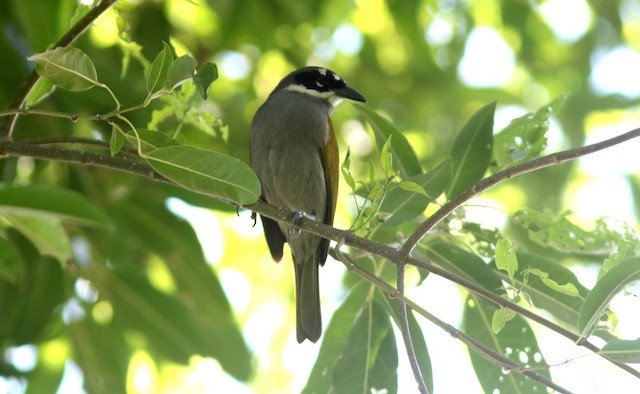
Gray-crowned Palm-Tanager. (Jacmel, Haiti; February 15, 2017.) © Jim Tietz
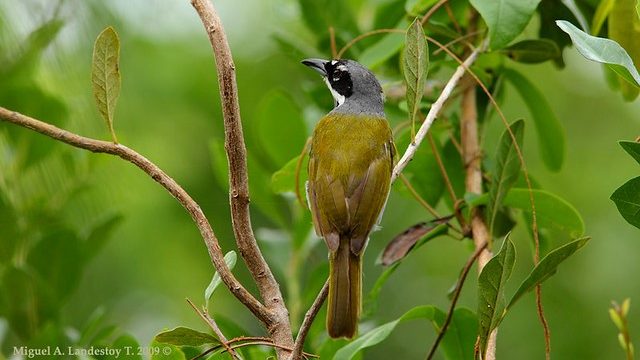
Gray-crowned Palm-Tanager, P. p. tetraopes. (Île-à-Vache, Haiti; June 7, 2009.) © Miguel A. Landestoy T.
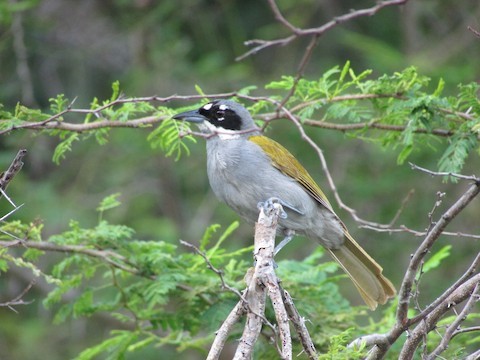
Gray-crowned Palm-Tanager. (Zanglais d’Aquin, Haiti; May 7, 2016.) © Sean Christensen
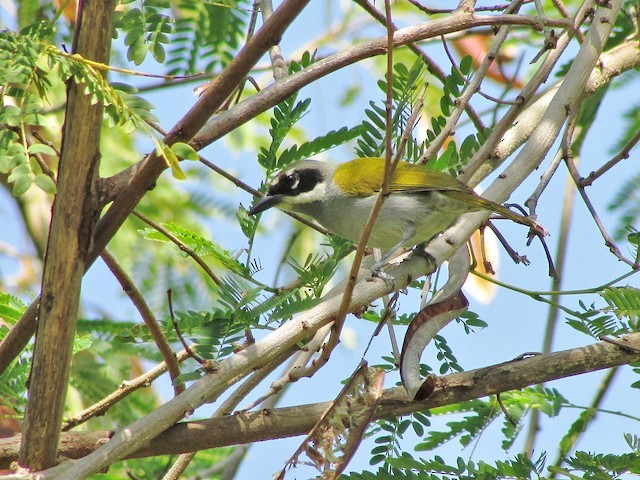
Gray-crowned Palm-Tanager. © Sean Christensen

Gray-crowned Palm-Tanager. (Zanglais d’Aquin, Haiti; February 11, 2017.) © Sean Christensen
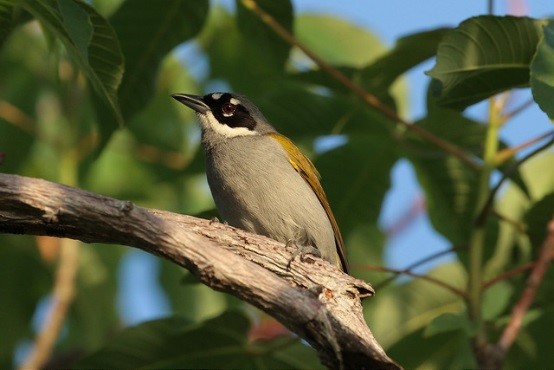
Gray-crowned Palm-Tanager. (Jardins sur Mer, Haiti; May 3, 2015.) © Charles Davies
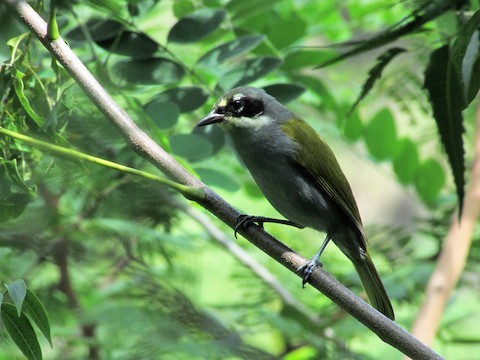
Gray-crowned Palm-Tanager. (Zanglais d’Aquin, Haiti; October 27, 2018.) © Sean Christensen
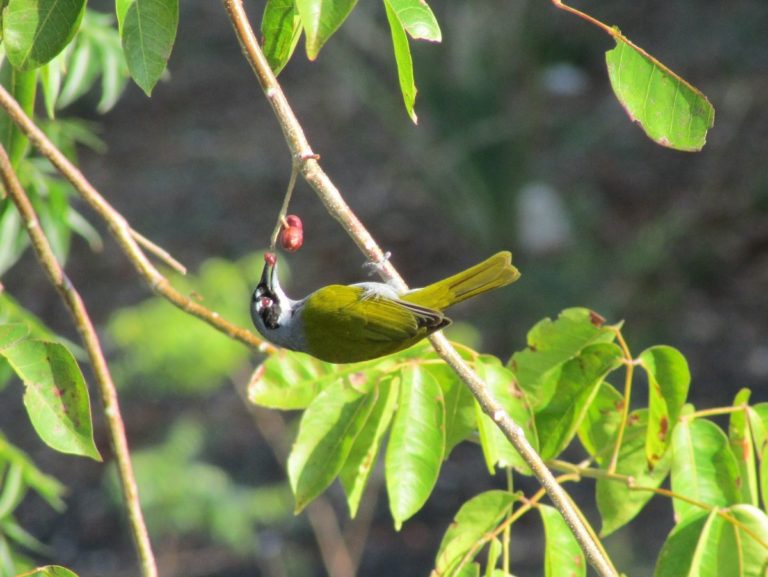
Gray-crowned Palm-Tanager. (Zanglais d’Aquin, Haiti; February 11, 2017.) © Sean Christensen
Voice. Common call is a high-pitched, squeaky pwee.
Cf. Black-crowned Palm-Tanager. In southeastern Haiti and possibly in the southwestern Dominican Republic, the two palm-tanagers sometimes occur together, and they have been reported to interbreed rarely in the overlap zone. Adult Black-crowned is distinguished by its all-white throat, substantial white eyebrow, and full black “helmet,” including the whole crown.
Immature Black-crowned has a gray crown in a pattern that is essentially indistinguishable from Gray-crowned’s unless studied in a photograph. The most reliable field mark is the pattern of gray and white on the underparts: Black-crowned has an all-white throat and some amount of white that extends down the middle of the breast; whereas Gray-crowned’s underparts are nearly all-gray, with just a small area of white on the chin that extends back along the lower cheek as a broad whisker. The two also differ in the size of the white marks on the face—these are much larger on Black-crowned.
Notes
Polytypic species consisting of three recognized subspecies: poliocephalus, tetraopes (Île-à-Vache), and coryi (Gonâve). Has sometimes been regarded as conspecific with Black-crowned Palm-Tanager, but genetic evidence and the stable coexistence of the two forms make this hypothesis untenable.
IUCN Red List Status: Near Threatened.
Two Species of Palm-Tanager. Several authors have considered Black-crowned and Gray-crowned Palm-Tanagers to be conspecific based on reported hybridization in southeastern Haiti. However, recent mitochondrial DNA studies indicate that the two forms diverged over 2 million years ago and are more distantly related than many other forms recognized as distinct species. If they were truly conspecific, it would be difficult to explain why one does not genetically overwhelm the other, as they inhabit essentially the same habitat on the same island and yet the distinction between them appears to be stable.
References
Alas & Colores: Grey-Crowned Palm-Tanager (Phaenicophilus poliocephalus), https://alasycolores.com.do/en/aves/cuatro-ojos-cabeza-gris.
BirdLife International. 2016. Phaenicophilus poliocephalus. The IUCN Red List of Threatened Species 2016: e.T22722301A94760200. http://dx.doi.org/10.2305/IUCN.UK.2016-3.RLTS.T22722301A94760200.en. (Accessed October 22, 2017.)
eBird. 2019. eBird: An online database of bird distribution and abundance. Cornell Lab of Ornithology, Ithaca, N.Y. http://www.ebird.org. (Accessed June 8, 2019.)
Hilty, S. 2017. Grey-crowned Palm-tanager (Phaenicophilus poliocephalus). In: del Hoyo, J., A. Elliott, J. Sargatal, D.A. Christie, and E. de Juana (eds.). Handbook of the Birds of the World Alive. Lynx Ediciones, Barcelona. http://www.hbw.com/node/61848. (Accessed October 22, 2017).
Latta, S., C. Rimmer, A. Keith, J. Wiley, H. Raffaele, K. McFarland, and E. Fernandez. 2006. Birds of the Dominican Republic and Haiti. Princeton University Press, Princeton, N.J.
Raffaele, H., J. Wiley, O. Garrido, A. Keith, and J. Raffaele. 1998. A Guide to the Birds of the West Indies. Princeton University Press, Princeton, N.J.
Sly, N.D., A.K. Townsend, C.C. Rimmer, J.M. Townsend, S.C. Latta, and I.J. Lovette. 2010. Phylogeography and conservation of the endemic Hispaniolan Palm-Tanagers. Conservation Genetics 11: 2121-2129.
Townsend, J.M. 2009. Gray-crowned Palm-Tanager (Phaenicophilus poliocephalus), version 1.0. In Neotropical Birds Online (T.S. Schulenberg, ed.). Cornell Lab of Ornithology, Ithaca, New York. https://doi.org/10.2173/nb.gcptan1.01.

